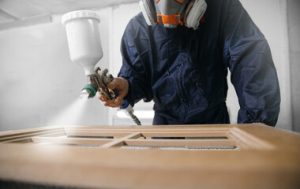Mortgage lenders are the entities that provide loan products and services to home buyers. They may also service (maintain records and collect payments) or buy mortgage loans that they originate.

Mortgage brokers operate independently and offer a wider range of loan options. Mortgage lenders are typically employees of financial institutions and may have fewer loan options. Click Here to learn more.
Mortgage lenders come in a variety of types, including banks, credit unions and online lenders. There are also different types of loan products that they offer, such as conventional loans or government-backed mortgages. Knowing what options are available can help you select the right lender for your unique needs.
When shopping for a mortgage, it is important to compare rates and terms offered by different lenders. Even a slight difference in interest rate can have a significant impact on monthly mortgage payments and the total cost of the loan over time. It is also important to evaluate the types of loan programs that a lender offers, including the availability of specialized loan programs such as VA or FHA loans.
Choosing the right type of lender for your mortgage can be a complicated process. There are many factors to consider, including the lender’s reputation, technology and responsiveness. In addition, it is helpful to understand the different types of loans that are available, as well as the requirements and fees associated with each.
Conventional loans are typically backed by Fannie Mae or Freddie Mac, which require borrowers to meet certain eligibility standards. These loans are generally considered the best option for most borrowers, as they provide competitive interest rates and low closing costs. However, this type of loan has higher requirements than other loan types and requires a higher credit score.
Credit unions are private lenders that are owned by their members. Unlike banks, they do not have to be federally chartered and may operate differently than other financial institutions. Some credit unions may offer a wider range of loan products and services than other lenders, while others may focus on offering competitive deposit and savings rates.
A national lender is a type of financial institution that offers a broad range of mortgage and consumer lending products nationwide. These lenders can be found in a variety of locations, from major metropolitan areas to small towns. These lenders can often provide competitive rates due to their access to a large pool of potential borrowers. They can also offer a wide variety of mortgage options, from conventional loans to jumbo loans.
Fees
Many mortgage lenders charge various fees, and you need to be aware of these charges. Two of the most common fees are loan origination and interest rate points. Both can have a major impact on your monthly mortgage payment. You should always ask your lender for a detailed breakdown of these fees and compare offers from multiple lenders to ensure you’re getting the best deal.
Lender fees typically include an application fee, processing fee and underwriting fee. These are usually flat fees, but they can be a percentage of your loan amount. In addition, most lenders will require a credit report fee to cover the cost of pulling your history and scoring information. The Consumer Financial Protection Bureau (CFPB) has put these fees on its list of junk fees, but you may be able to shop around for this service and get a lower fee from another provider.
Mortgage lenders also charge a prepaid homeowners’ insurance and property taxes fee, which are typically incurred at closing. They will also charge a courier fee to transport the original and copies of the closing documents to the final signing location. These expenses can add up to a significant sum and are often hidden in the fine print.
You can expect to pay additional third-party fees, such as an attorney fee and survey fee if applicable, as well as any municipal or county taxes due on the home you are purchasing. These are typically disclosed on the Loan Estimate, and you can negotiate them to reduce your overall costs.
Some communities have homeowner’s association (HOA) fees, which are a monthly charge to manage community standards and rules. These fees are not a part of your mortgage and must be paid separately. In addition, you will likely pay a one-time fee to register the change in ownership of your house with the HOA. This is typically included in your closing costs. Finally, if you choose to purchase an FHA or VA mortgage, there are varying government-sponsored fee amounts, which are typically included in your closing costs. You can also buy discount points at closing to reduce your lifetime interest rate, but this only makes sense if you plan to stay in the home for a long time.
Qualifications
A mortgage lender is a company that lends money to individuals seeking a home loan. They make credit decisions based on borrower-specific borrowing criteria, such as credit history, income and debt. They also set the terms of the loan, including interest rate and down payment requirements. Mortgage lenders can be a bank or a separate lending entity. They may offer different products and have unique underwriting processes.
When choosing a mortgage lender, it is important to consider their reputation, customer service and loan officer expertise. Online reviews and testimonials can provide valuable insights into past borrower experiences with the lender. Additionally, evaluating the lender’s technology, responsiveness and clarity of communication can be helpful.
The qualifications required for a mortgage lender vary by state. In New Jersey, a Residential Mortgage Lender License is required for any natural person who, for compensation or gain, takes a residential mortgage loan application and makes, negotiates, originates or services a residential mortgage loan on New Jersey property. This individual must complete a minimum of 20 hours of pre-licensing education courses approved by the National Mortgage Licensing System (NMLS).
Mortgage lenders review various factors to determine whether or not a potential borrower qualifies for a loan. One of the most important considerations is the borrower’s employment history. A stable, consistent employment history indicates that the borrower has a steady source of income and is capable of paying back their mortgage. Lenders may require verification of employment, examining several months worth of pay stubs to ensure that the borrower is able to afford the monthly mortgage payments.
Other considerations for a mortgage lender include the borrower’s debt to income ratio and current financial situation. Lenders will look at the borrower’s total debt to income, considering their unsecured and secured debt, such as student loans, auto loans and credit card debt. In addition, they will look at the borrower’s current income and employment status, taking into account base pay or wages along with any bonus or incentive compensation.
Finally, mortgage lenders will take into account the borrower’s housing expense to income ratio, ensuring that their mortgage payment will not exceed 30% of their monthly gross income. This is an important consideration for many borrowers as it helps ensure that they will be able to comfortably afford their mortgage payment and cover essential living expenses.
Closing
Once you’ve completed the mortgage loan process, it’s time to close on your new home. This final step involves signing a mortgage note and deed of trust that bind you to repay your loan and give your lender the right to take back your home should you default on payments. The closing process also includes the review of documents related to the closing costs and a Closing Disclosure that summarizes changes to your loan’s terms since the initial Loan Estimate. It’s important to review this document carefully and pay special attention to any discrepancies.
During the closing, you’ll also be asked to set up an escrow account for the purposes of paying your property taxes and homeowners insurance. Some lenders require that you establish an escrow account while others allow you to waive the fee. The choice of how you hold title to your property may have estate planning and tax implications, so it’s important to consult with a financial professional before closing.
Local lenders understand your needs and provide a personalized approach that aligns with your specific financial goals. They will work with you throughout the entire process, from pre-qualification through closing to ensure that your interests are protected. This helps to eliminate frustration and confusion that can occur in the mortgage process when dealing with large, impersonal institutions.
It is important to shop around and compare rates, fees, terms, and customer experience before selecting a lender for your mortgage. Some lenders offer similar interest rates, but different fees and closing costs can make a big difference in your total cost of ownership. You should also consider whether you’ll be able to afford your mortgage payments with the home you want.
During the closing process, it is common for your lender to request additional documentation from you and there may be delays due to unexpected circumstances. During this period, it is crucial to stay in constant communication with your lender and ask any questions you may have. It is also a good idea to schedule an appointment with your lender at least three days prior to closing to review your Closing Disclosure, which details the final loan terms and closing costs.








